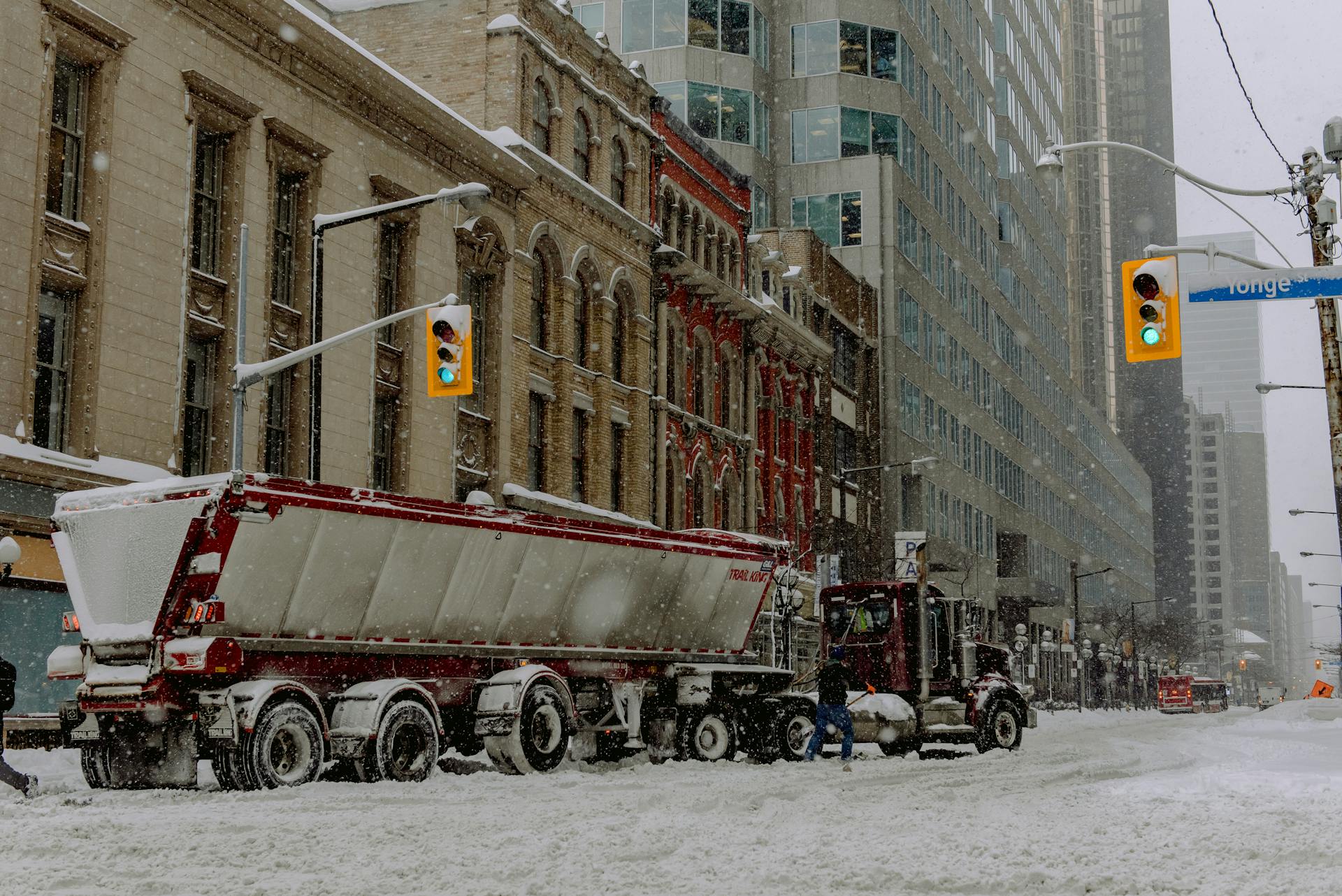
Semi trucks are a common sight on our roads, but have you ever stopped to think about the safety and maintenance essentials that keep them rolling?
Regular maintenance is crucial for semi trucks, with many owners and operators adhering to a 10,000-mile oil change schedule.
To ensure safe operation, semi trucks are equipped with advanced safety features, including electronic stability control and lane departure warning systems.
Semi trucks are also required to have a comprehensive maintenance log, which includes records of tire pressure checks and brake inspections.
A well-maintained semi truck can significantly reduce the risk of accidents and breakdowns on the road.
Sharing the Road
Maintaining a safe following distance is essential when driving behind a semi-truck. Allow a four-second distance between you and the big rig ahead to ensure you won't hit the truck if it stops suddenly.
If you're in a hurry, it's better to slow down and allow truck drivers the time they need to get up to speed. A big rig can take 600 feet to stop when traveling 65 miles an hour.
Semi-trucks have enormous blind spots, so it's crucial to stay out of them. A big rig's blind spots are multiple car lengths long on each side and cover at least two lanes to the right of the truck.
To avoid cutting off a semi-truck, make sure you can see the complete truck in your rearview mirror before pulling into the lane ahead. This is especially important when the truck is traveling at high speeds.
Here are some key things to remember when sharing the road with semi-trucks:
By following these simple tips, you can help ensure a safe and smooth journey when sharing the road with semi-trucks.
Types of Semi Trucks
Semi trucks are a common sight on the road, and it's essential to know what to expect from these massive vehicles. A tractor trailer is a "tractor and semitrailer combination" where the tractor is the engine and cab, and the semitrailer is the boxy part it pulls.
These trucks have enormous blind spots, making it difficult for drivers to see other vehicles, especially in the area 20 feet directly in front of the cab, 30 feet directly behind the trailer, and on either side. If you can't see a truck driver in his rear-view mirror, he can't see you either! This means a truck could change lanes right on top of your car without knowing you're there until it's too late.
Tractor trailers also pose a significant rollover hazard, especially on sharp curves, at highway speeds, or on roads without large shoulders. They're top-heavy and can easily tip over if one wheel runs off the road surface onto a low shoulder.
Tractor Trailers/Big Rigs
Tractor Trailers/Big Rigs are a common sight on highways, but they come with unique hazards. A tractor trailer is essentially a tractor and semitrailer combination, with the tractor being the engine and cab where the driver sits, and the semitrailer being the boxy part pulled behind it.
The blind spots created by these massive vehicles are enormous. On a standard tractor-plus-one-trailer semi, the driver is blind to the area 20 feet directly in front of his cab, 30 feet directly behind his trailer, and one lane-width over his left shoulder extending all the way to the back of the truck.
Tractor trailers are also top-heavy and prone to rollovers, especially on sharp curves, at highway speeds, or in high crosswinds. They carry loads that can shift dangerously if not secured properly, and a single wheel running off the road surface can send the whole rig tumbling.
Truckers who drive too fast or with too little sleep are a major contributor to accidents involving tractor trailers. This combination can lead to trucks not being able to stop soon enough to avoid collisions, making it crucial for other drivers to exercise caution when sharing the road with these massive vehicles.
Tanker Truck
Tanker trucks are basically tractor-trailers with specialized tank trailers that carry liquids, including water, milk, and potentially flammable or toxic cargo.
State and federal governments require tanker truck drivers to have special permits and follow strict safety precautions.
Tanker trucks have the same blind spots as a typical tractor-trailer.
Tankers haul liquefied gases, fuels, industrial chemicals, food-grade liquids, and even raw sewage.
Flammable cargo can cause massive damage if it escapes the tank, resulting in explosions.
Flatbed
Flatbed trucks are perfect for carrying odd-shaped and oversized cargo that doesn't fit in standard-sized box trailers. They come in different sizes, with trailers typically about 48 feet long.
Rigid flatbed trucks have a direct connection between the trailer and cab, while articulated flatbed trucks have a hitching mechanism that allows the trailer to pivot when turning. The majority of flatbed trucks are the maximum width allowed by the FMCSA, but some are larger.
Wide loads, which are carried by larger flatbed trucks, pose many hazards to drivers of other vehicles, especially in bad weather conditions. They take up more than one lane, making passing them difficult and risky.
Give flatbed trucks the space they need, especially when you see them carrying wide loads.
Wheels and Tires
Semi trucks can be equipped with dual wheels or single, wider tires known as super singles. Dual wheels are the most common, but super singles are gaining popularity among weight-sensitive operators.
Super singles reduce fuel consumption by 10% as shown in tests on an oval track in 1999. This is because fewer tire sidewalls are flexing, which means less energy is wasted.
The lighter overall tire weight of super singles allows trucks to be loaded with more freight. In Europe, this led to the replacement of two 10-tonne axles with three 8-tonne axles on wide-base single wheels.
Super singles have a significantly lower axle weight, which affects road wear compared to dual wheels. The majority of super singles sold in Europe have a width of 385 mm (15.2 in).
The standard 385 tires have a legal load limit of 4,500 kg (9,900 lb).
Safety Features
Semi trucks on the road have a range of safety features designed to prevent accidents and protect drivers and other road users.
Many semi trucks are equipped with electronic stability control systems, which can help prevent skidding and loss of control on slippery roads.
These systems work by automatically adjusting engine power and applying the brakes to individual wheels as needed.
Anti-lock braking systems (ABS) are also common in semi trucks, and can help prevent wheels from locking up and causing the vehicle to skid or lose traction.
This can be especially important on wet or icy roads, where stopping quickly can be a challenge.
Some semi trucks also feature lane departure warning systems, which can alert the driver if the vehicle starts to drift out of its lane.
Avoid Blind Spots
Avoiding blind spots is crucial for safe driving. The Federal Motor Carrier Safety Administration (FMCSA) indicates that trucks have very large blind spots along every side of the vehicle.
Trucks have blind spots along the right and left side of the vehicle. These areas are where the truck driver will not be able to see other vehicles, even using their mirrors.
If you must pass a truck, be aware that you'll have to be in the blind spot for a moment, but don't dwell there.
Underride Guard
An underride guard is a critical safety feature designed to prevent vehicles from sliding under the rear or side of a trailer or truck in the event of a collision.
These guards are typically made of metal and are installed on the rear or side of the trailer or truck. The National Highway Traffic Safety Administration (NHTSA) has established regulations for underride guards, requiring them to be able to withstand a certain amount of force before deforming.
In the United States, the NHTSA estimates that underride guards can prevent up to 40% of all underride crashes, which can be particularly devastating due to the severity of the impact.
The Federal Motor Carrier Safety Administration (FMCSA) also requires all new trailers and trucks to be equipped with underride guards, starting in 1998.
Braking
Braking systems are designed to stop your vehicle quickly and safely, and most modern cars come equipped with anti-lock braking systems (ABS). ABS prevents your wheels from locking up during hard braking, which can cause skidding and loss of control.

The average stopping distance for a car traveling at 60mph is around 120 feet, and ABS can reduce this distance by up to 30 feet. This is because ABS can stop your car more quickly and smoothly, giving you more time to react to hazards on the road.
Electronic stability control (ESC) systems, which are often paired with ABS, can also help prevent your car from skidding or losing traction during hard braking. By applying the brakes to individual wheels, ESC can help your car stay stable and on course.
In emergency situations, it's essential to brake smoothly and gradually, rather than slamming on the brakes. This can help prevent your car from skidding or losing control, and can also reduce wear and tear on your brakes.
Transmission
Semi-trucks often have manual transmissions to give drivers maximum control over their loads.
A manual transmission can have as few as three forward speeds or as many as 18 forward speeds, plus two reverse speeds. The number of transmission ratios is crucial for efficient engine operation.
Modern on-highway diesel engines are designed to provide maximum torque in a narrow RPM range, usually between 1200-1500 RPM. This means drivers can hold the engine in its optimum range regardless of road speed.
A ten-speed manual transmission, for example, is controlled via a six-slot H-box pattern, similar to that in five-speed cars. The shift pattern is the same for gears one to five and gears six to ten.
Some semi-trucks have a clutch brake, which stops the rotation of the gears and allows the truck to be put into gear without grinding when stationary. This is especially useful for trucks with constant-mesh transmission.
Other Terms
Semi-trucks are commonly referred to by many names, and it's helpful to know what they're called in different parts of the world.
In the United States, semi-trucks are often called semi-trailers, semi-trucks, or simply "sems." I've noticed that truckers often use the term "semi" in casual conversation.
These terms are all used to refer to the same type of vehicle, which is a combination of a tractor unit and a semi-trailer.
Truck drivers in the US also use terms like "big rig" and "eighteen-wheeler" to describe their vehicles.
In other parts of the English-speaking world, semi-trucks are known as articulated lorries, articulateds, or juggernauts.
Here are some of the common names used for semi-trucks in different regions:
Frequently Asked Questions
Are semi-trucks allowed on residential roads?
Large semi-trucks are generally allowed on residential streets unless otherwise posted, but regulations can vary by state and municipality
Why are there so many semi-trucks on the road?
Semi-trucks are often parked on the side of the road due to various factors, including maintenance, weather, and traffic conditions. Understanding these reasons can provide valuable insights into the logistics and operations of the trucking industry.
Are there self driving semi-trucks on the road today?
Yes, self-driving semi-trucks are being tested on public highways, but they are accompanied by human safety drivers. While they have accumulated over 1 million miles of autonomous driving experience, they are not yet fully self-sufficient on the roads.
Sources
- https://www.roadwaysafety.org/blog/how-safely-share-road-semi-trucks
- https://tpmblegal.com/5-tips-for-sharing-the-road-with-semi-trucks/
- https://www.wawanesa.com/us/blog/roadway-etiquette-the-dos-and-don-ts-of-sharing-the-road-with-semi-trucks
- https://attorneyguss.com/blog/common-trucks-on-the-road/
- https://en.wikipedia.org/wiki/Semi-trailer_truck
Featured Images: pexels.com

